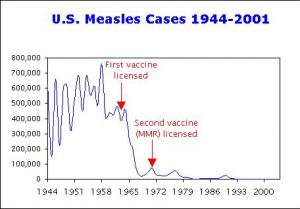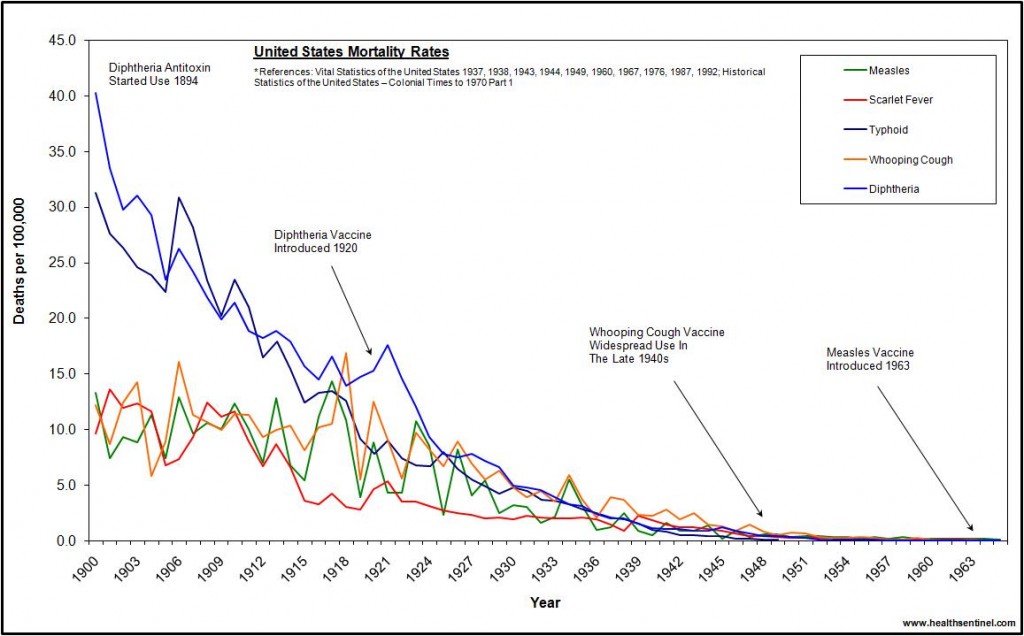Probably one of the most contentious, acrid debates going on anywhere over the last five to ten years has been on the topic of vaccine safety. Go to any active forum that discusses children’s health and you will see some very heated arguments. On one side, you have concerned parents relaying scary stories about developmental disorders that coincided to-the-day with vaccine doses. And on the other side, screeds of scientific and medical research in support of vaccine safety and efficacy.
Just to give you an idea of how heated this really is, here is Penn & Teller in a YouTube video about vaccines (with some NSFW language).
Now, full disclosure. I have a beautiful, healthy two year old daughter who has not been vaccinated. However, I am only one part of the team that makes that decision. My wife is firmly in the no-vaccine camp, whereas I am more on the fence (not surprisingly she has her way!). But being on the fence has allowed me to take a more dispassionate view of the issues. I’ve watched many pro and anti vaccine videos, and to be honest, neither side has convinced me one way or the other.
Firstly, there are just obvious misuses of data to prove a point. Take the claim in the Penn & Teller video that thousands of children’s lives have been saved by vaccines. The graph below of measles cases in the US since 1944 supports their claim (and is no doubt where it came from). Since 1963 when the first measles vaccine was licensed in the US, the number of measles cases plummeted and is now all but eradicated compared to earlier in the century – pretty strong evidence for the effectiveness of vaccines.
Now look at this graph representing the other side of the debate.
This is a graph of mortality rates for various diseases in the US since 1900. The measles line is in red and starts off at around 10 deaths per 100,000 early in the century, dropping away to well below 1 death per 100,000 by the time the measles vaccine was introduced in 1963. So contrary to Penn & Teller, vaccines didn’t actually save us from a disease infested society with children dying off left, right and center. In fact, due to obvious improvements in health and sanitation, the mortality rates of most major diseases were negligible by the time vaccines were introduced.
So who who is right? Well, it’s a matter of degree. Penn & Teller are wrong when they equate vaccines with saving thousands of lives compared to non-vaccinated children. The data tells us that most of those children weren’t dying from these diseases by the time vaccines were introduced.
However, the anti-vaccine camp is wrong in saying that vaccines haven’t been effective. They have. While they may not have drastically reduced the number of children dying from common diseases like measles, they have all but eradicated the incidence of these diseases. If this in turn reduces mortality rates to almost zero, that’s still children’s lives being saved. It may not be thousands of children, but if you’re a parent, one is enough.
So it’s fair to say vaccines are effective and they do save lives. However, that’s not the end of the story.
In the anti-vaccine camp there is also a strong belief that vaccines are dangerous. Particularly that they can cause, or are a significant factor in causing, autism in children.
This is where the data starts to get a bit murky – which will surprise many people who thought vaccines were completely safe and that vaccine-autism connections were just ‘junk science’. In fact, there is actually no clear data indicating a link one way or another. Which is worrying.
This is a quote from the Centers for Disease Control’s website (link here) rejecting a causal relationship between a common preservative in vaccines (thimerosal) and Autism (ASD).
Recent estimates from CDC’s Autism Developmental Disabilities Monitoring networkfound that about 1 in 150 children have ASD. This estimate is higher than estimates from the early 1990s. Some people believe increased exposure to thimerosal (from the addition of important new vaccines recommended for children) explains the higher prevalence in recent years. However, evidence from several studies examining trends in vaccine use and changes in autism frequency does not support such an association. Furthermore, a scientific review
by the Institute of Medicine (IOM) concluded that “the evidence favors rejection of a causal relationship between thimerosal-containing vaccines an autism.” CDC supports the IOM conclusion.
This kind of finding always worries me because the devil is typically in the detail. So after actually downloading and reading through the IOM report, sure enough, while the ‘causal relationship’ between thimerosal containing vaccines and autism can’ t be substantiated, there were some interesting caveats. They type of caveats that never get reported in media coverage.
Citing the shear amount of submissions they received on this topic:
The volume of correspondence to the committee on this issue is impassioned and impressive. There are, however, little data to shed light on how many families believe that vaccination actually caused their child’s autism, so that the magnitude of concern in the general population is uncertain. However, the committee concludes that because autism can be such a devastating disease, any speculation that links vaccines and autism means that this is a significant issue.
And then it goes on to say:
There are many examples in medicine of disorders defined by a constellation of symptoms that have multiple etiologies, and autism is likely to be among them. Determining a specific cause in the individual is impossible unless the etiology is known and there is a biological marker. Determining causality with population based methods such as epidemiological analyses requires either a well-defined at-risk population or a large effect in the general population. Absent biomarkers, well-defined risk factors, or large effect sizes, the committee cannot rule out, based on the epidemiological evidence, the possibility that vaccines contribute to autism in some small subset or very unusual circumstances. However, there is currently no evidence to support this hypothesis either. (emphasis mine)
That’s a pretty startling finding given that it’s in a paper on the CDC website. It basically says that given the evidence, while there is nothing to support a vaccine-autism connection, that’s only because the effect in the population might not be large enough.
If you look at parents who believe their child became autistic due to a vaccine, the very definition of this group is ‘small subset or very unusual circumstance’. It’s amazing to me that this paragraph isn’t cited more often in this debate.
So in short, vaccines are effective, but they aren’t cornerstones to a disease free society. They have been responsible for (almost) eradicating many diseases that were already in decline due to natural improvements in health and sanitation. However, their side-effects (particularly their connection to autism) aren’t well understood. It’s possible that small sub-sets of the population are at risk.
It might not be thousands of children in that group, but as a parent, one is enough.


2 Responses to “The Vaccine Debate”